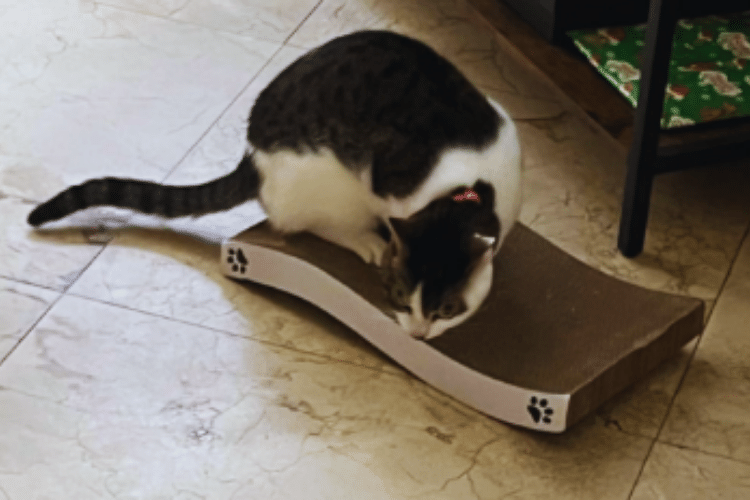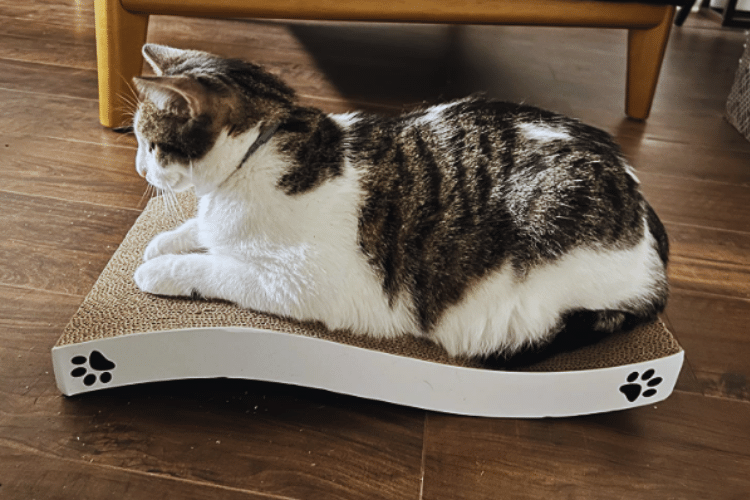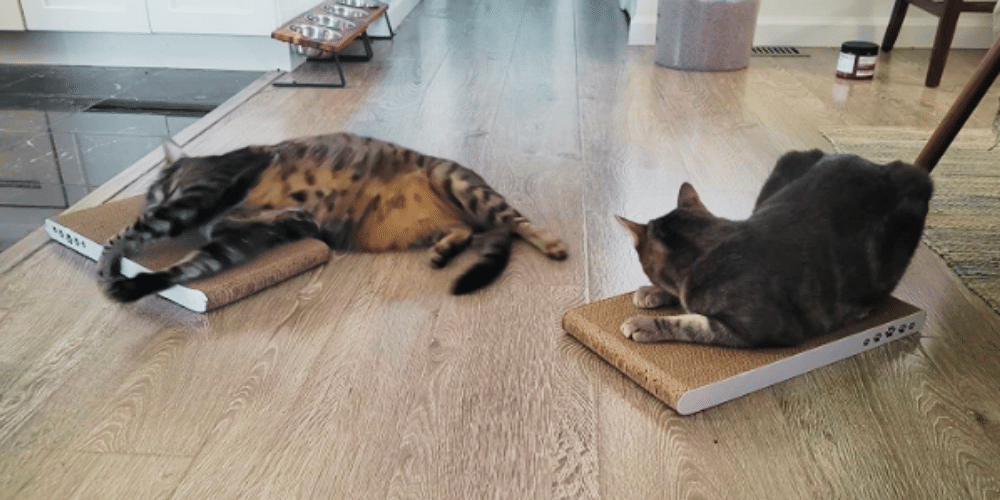Are you a cat lover looking for the ideal scratcher for your feline friend? If so, understanding which type of cardboard is used to make cat scratchers can help you select the perfect one.
Cardboard is often an attractive material because it’s affordable, durable and relatively light compared to other materials such as wood or plastic. But there are many types of cardboard out there, so what kind should be used in cat scratch boards?
In this article, we will go over the different cardboard varieties on offer that will provide cats with hours of fun!

Choosing the Right Cardboard for Cat Scratchers
Cats have an instinct to scratch and climb. It helps them stretch their muscles, mark their territory, and keep their claws healthy. However, it can be frustrating for pet owners when cats scratch the furniture, carpets, or walls.
That's why investing in a good cat scratcher can be a smart choice. But have you ever wondered what kind of cardboard is used for cat scratchers?
In this article, we'll explore the different types of cardboard and how to choose the right one for your feline friend.
Corrugated Cardboard
The most common type of cardboard used for cat scratchers is corrugated cardboard. It is made up of three layers - an inside liner, an outside liner, and a middle layer of fluted paper.
The flutes provide a natural texture for cats to scratch and the layers make it sturdy enough to withstand their claws. Corrugated cardboard scratchers come in various shapes and sizes, including flat boards, ramps, and posts. They are inexpensive, easy to replace, and eco-friendly.
Honeycomb Cardboard
Another type of cardboard used for cat scratchers is honeycomb cardboard. It is made up of small triangular cells that create a hexagonal pattern. Honeycomb cardboard scratchers are denser, firmer, and more durable than corrugated cardboard scratchers.
They have a smoother texture that cats may prefer or avoid depending on their preference. Honeycomb cardboard scratchers can be heavier and more expensive than other types of scratchers, but they can last longer.
Recycled Cardboard
If you're looking for an eco-friendly option, you can choose a cat scratcher made of recycled cardboard. Recycled cardboard is made of post-consumer waste, which reduces the amount of waste thrown into landfills.
Recycled cardboard scratchers are similar in texture, durability, and price to corrugated cardboard scratchers. Some brands offer scratchers with refillable cardboard inserts, which reduces waste even further.
Cardboard with Catnip or Cat Lure
To attract your cat to the scratcher, some brands offer cardboard with catnip or cat lure sprinkled on top. Catnip is a fragrant herb that induces a euphoric response in cats, while cat lure is a synthetic scent that mimics the smell of catnip.
Adding catnip or cat lure to the scratcher can encourage your cat to use it and enhance their scratching experience. However, not all cats respond to catnip or cat lure, so it's best to observe your cat's reaction.

Scratcher Design and Placement
Aside from the type of cardboard, the design and placement of the scratcher also matter. Cats prefer vertical scratchers that mimic tree trunks or posts, as they can stretch their bodies and sharpen their claws. Horizontal scratchers like flat boards or ramps are also popular for cats who like to sprawl or rub their faces.
It's best to place the scratcher in an accessible and visible spot, such as near a window or a favorite sleeping area. You can also encourage your cat to use the scratcher by scratching it yourself or using toys.
Choosing the right cardboard for your cat's scratcher can make a difference in their health and happiness. Corrugated cardboard, honeycomb cardboard, and recycled cardboard are popular options with different textures, durability, and eco-friendliness.
Adding catnip or cat lure can also enhance their scratching experience, but it's not a guarantee. Don't forget to consider the design and placement of the scratcher to encourage your cat to use it.
With the right cardboard, your cat can scratch and climb to their heart's content while protecting your furniture and improving their well-being.
List of Top 5 FAQs About Choosing the Right Cardboard for Cat Scratchers
Are you an avid cat lover looking for the best kind of cardboard to use for your feline's favorite scratcher? Don’t worry – we have you covered! In this section, we will address this very important question of what kind of cardboard should be used for store bought cat scratchers.
We’ll explore why certain types are more suitable than others and provide a list of key features to look out for when choosing which type of card stock is right for your kitty.
So whether you're in the market looking to purchase a new scratcher or already own one but want some insight on how to make it last longer, read on and learn the answers to all your questions here!
What are the important properties to consider when choosing cardboard for a cat scratcher?
- The thickness and density of the cardboard: Thicker and denser cardboard tends to be more durable and long-lasting.
- Scratchability: Look for cardboard that has a rough surface, as it provides better traction and encourages scratching behavior.
- Non-toxic and eco-friendly materials: Ensure that the cardboard is made from safe and sustainable materials that won't harm your pet.
How long can I expect a cardboard cat scratcher to last?
- The lifespan of a cardboard cat scratcher depends on various factors such as the quality of the cardboard, the frequency of use, and the size and activity level of your cat.
- On average, a well-maintained cardboard scratcher can last anywhere from several weeks to several months. However, it's important to regularly monitor the condition of the scratcher and replace it if it becomes excessively worn or damaged.
Are cardboard cat scratchers safe for my cat to use?
- Yes, cardboard cat scratchers are generally safe for cats to use. However, it's crucial to choose a high-quality product made from non-toxic materials to ensure your cat's safety.
- Additionally, monitor your cat's behavior while using the scratcher to prevent any potential hazards such as ingesting cardboard pieces or getting their claws stuck in the material.
How can I maintain a cardboard cat scratcher to ensure my cat's safety and enjoyment?
- Regularly inspect the scratcher for signs of wear and tear. Replace it if any loose or exposed cardboard edges could potentially harm your cat.
- Clean the scratcher periodically by gently vacuuming or brushing off loose debris. Avoid using water or cleaning agents that may weaken the cardboard.
- Consider rotating or repositioning the scratcher occasionally to maintain your cat's interest and prevent excessive wear on one area.
Can I recycle a cardboard cat scratcher once it's no longer usable?
- Yes, cardboard cat scratchers are typically recyclable. Check with your local recycling guidelines to ensure proper disposal.
- Some manufacturers also offer recycling programs for their products, so you may want to explore those options as well.
In summary, it is important to understand the type of cardboard used for cat scratchers. Different types of boards have varying qualities that can affect your cat’s health.

Corrugated board is the most popular type and is available in a variety of strengths and configurations. Single wall board isn't as strong as corrugated but still works well for projects like kitty comfort scratch pad holders or couch corner protectors.
Triple wall board offers a sturdy base for heavy-duty tubes and posts as well as innovative shapes like double-sided arc scratch ramps.
No matter what type you choose, remember that cats need scratching pads! Make sure to choose one with quality construction to ensure that your furry feline friend has a cozy home accessory built to last.
Thank you for visiting LegitLists we hope this helps you make a legitimate choice!






